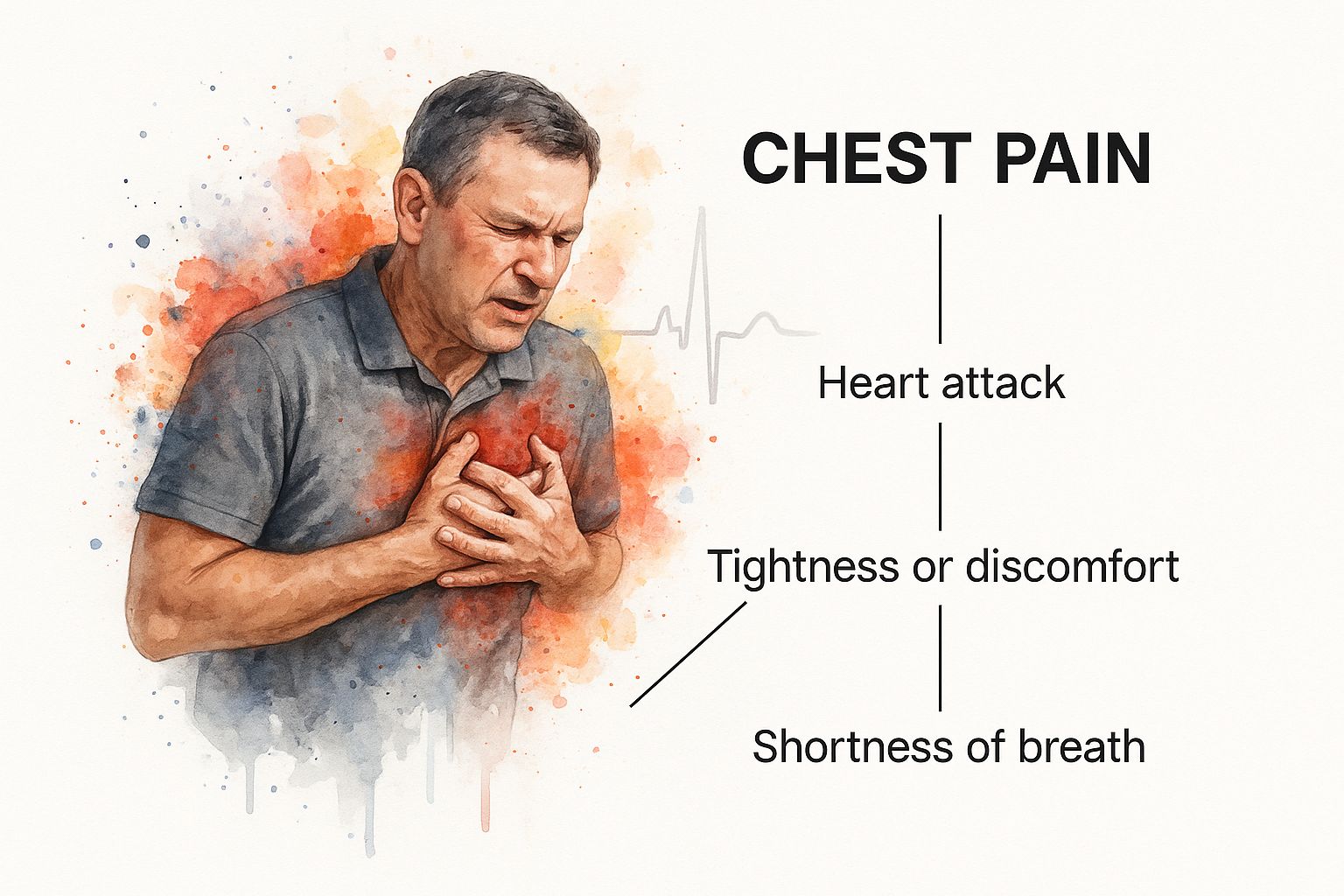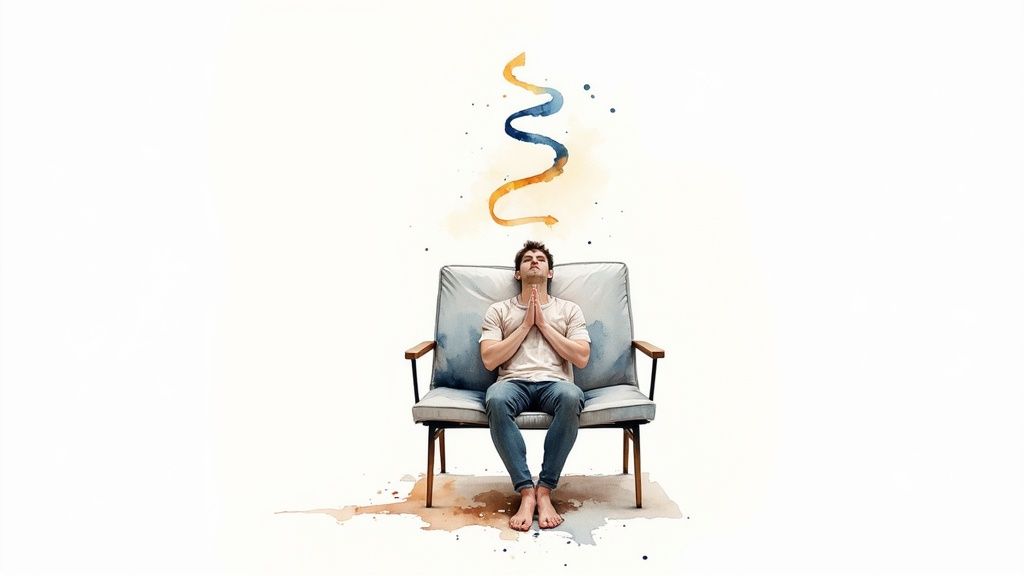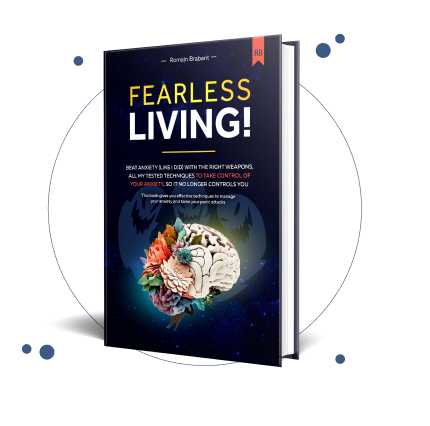
Once the intense, crashing wave of a panic attack finally pulls back, an unsettling quiet often takes its place. It’s a strange, disorienting space—the immediate terror is gone, but a sense of peace hasn't quite settled in. This is what many people call the ‘panic hangover,’ and understanding it is the first step toward lasting healing.
This period is defined by a profound sense of exhaustion, both physically and emotionally. Your body has just been through an immense ordeal, like sprinting a marathon you didn't even know you were running. The after-effects are not a sign of weakness; they are proof of what you've just endured, and a sign that your body is beginning its journey back to calm.
The Aftermath of a Panic Attack
The feelings that linger after the storm has passed can be just as confusing as the attack itself. You might feel a deep, bone-weary fatigue that no amount of sleep can seem to fix. Or maybe you're left with a sense of emotional fragility, where even the smallest thing feels completely overwhelming.
This is your body's normal and expected response to an extreme stress event. Your system was flooded with adrenaline and other stress hormones, and the ‘hangover’ is the physiological comedown from that intense surge. It's a natural, albeit draining, process of rebalancing, and a crucial part of the healing process.
Here’s a quick look at what you might be feeling in the hours or days after an attack.
Common Post-Panic Attack Symptoms
| Category | Common After Effects |
|---|---|
| Physical | Deep fatigue or exhaustion, muscle soreness or tension, headaches, lingering dizziness or lightheadedness, sensitivity to light and sound. |
| Emotional | Feeling emotionally fragile or "raw," increased irritability, a sense of detachment or unreality (derealization), lingering fear or dread about another attack. |
| Cognitive | Brain fog or difficulty concentrating, trouble with short-term memory, feeling mentally slow or "out of it," obsessive thoughts about the attack. |
Seeing these symptoms laid out can be validating. It shows that you're not imagining things—you're recovering from a significant physiological event.
Feeling Drained and Fragile
Simply validating these feelings is the first step toward healing. When you recognize that what you're feeling is a common and legitimate part of the process, it removes the layer of self-judgment that so often makes anxiety worse. You are not broken or failing; you are recovering.
Understanding this compassionate framework is the key to moving forward. If you're struggling to make sense of what just happened, you can learn more about what occurs during a full panic attack here.
This initial awareness builds a foundation of hope. By seeing these after-effects for what they are—your body's attempt to find its equilibrium again—you can start to reclaim your sense of calm. Healing isn't some distant possibility; it's a journey that starts by acknowledging and honoring this recovery phase. There is a clear way forward to a life without this fear.
Why Your Body Feels So Drained
A panic attack feels like your body’s emergency alarm system has been pulled, and the profound exhaustion that follows isn't just in your head—it’s a very real, biological event. Think of it as being forced to run a physiological marathon you never signed up for.
During the “fight or flight” response, your body is flooded with massive amounts of adrenaline and cortisol. These hormones are preparing you for what your brain perceives as an immediate, life-or-death threat, putting every system on high alert. Your heart pounds, your breathing accelerates, and your muscles clench, ready for action. This state burns through an incredible amount of physical and mental energy in an exceptionally short time.
The Adrenaline Comedown
Once the perceived danger fades and the panic subsides, your body is left to clean up the aftermath. The stress hormones that surged through your system begin to taper off, leaving behind what feels like a physiological "hangover." This is the real reason for that bone-deep fatigue and the muscle aches so many people report.
It’s your body’s natural recovery mode kicking in, much like how you’d feel after a grueling workout or a serious illness. Just understanding this can be a huge turning point.
The exhaustion isn't a sign that something is still wrong or that you're weak. It’s a clear signal that your body is working hard to return to a state of balance and has entered a much-needed recovery phase.
This perspective is so important because it helps you shift from a place of fear to one of self-compassion. Instead of getting stuck worrying about the lingering symptoms, you can start to see them as proof of your body’s resilience and give yourself the rest you genuinely need to heal.
A Widespread Experience
If this experience makes you feel isolated, it’s important to know you are far from alone. Panic attacks are a major global health issue, with a lifetime occurrence estimated at around 13.2% worldwide.
And for those who have panic attacks but don't meet the criteria for a formal panic disorder, a staggering two-thirds (66.5%) have recurrent episodes, not just a single event. You can discover more insights about the global prevalence of panic attacks and how they affect daily life.
This infographic helps visualize the intense physical storm a panic attack creates, which explains the drain that follows.

The image is a powerful reminder of the internal chaos a panic attack unleashes. An event this intense naturally requires a period of rest and recovery. This isn't a time for self-criticism, but for gentle self-care as your body and mind work together to find their way back to calm.
Breaking the Cycle of Fearing the Next Attack

Of all the lingering effects of a panic attack, perhaps the most challenging one isn’t physical at all. It’s the emotional echo that remains long after the exhaustion has faded—a persistent, nagging fear that it’s all going to happen again. This is called anticipatory anxiety, and it can feel like you’re constantly walking on eggshells, but it is a cycle that can be broken.
This fear is so much more than a passing worry. It’s a powerful force that can quietly begin to reshape your entire life. It’s that little voice whispering, "What if it happens again at the grocery store?" or "What if I have an attack while I'm driving?" These questions plant seeds of doubt that can easily grow into full-blown avoidance.
When Fear Starts Shrinking Your World
Anticipatory anxiety almost always leads to a cycle of avoidance. It might start small—you skip a social event you were looking forward to, or you change your commute to avoid a certain highway or bridge. In the moment, each decision feels sensible and protective. But when you add them all up, they can drastically shrink the boundaries of your world.
This response is completely understandable. Your brain is just trying to protect you from what it has registered as a very real threat. The problem is, this protective instinct can backfire, teaching your brain that the only way to stay safe is to steer clear of more and more of life.
The most important thing to realize here is that this fear cycle is not a permanent state. It is a learned response to a traumatic experience. And just like it was learned, it can be unlearned. This simple fact offers a clear and hopeful path toward regaining your freedom.
The feelings of vulnerability are real, and they are valid. But they don't have to define your future. You have the power to break this pattern.
Unlearning Fear and Reclaiming Your Life
Thinking of this fear as a learned habit is incredibly empowering. It reframes the problem from "something is wrong with me" to "I've developed a pattern that I can now change." This shift in perspective is the first and most powerful step toward healing.
The journey forward involves systematically teaching your brain that the situations you fear are not actually dangerous. It’s a process of gradually re-engaging with the world, but this time, you’re armed with new tools and a better understanding of what’s happening in your mind and body.
This isn't about recklessly "toughing it out." It’s a gentle, structured approach focused on:
- Understanding your triggers: Pinpointing what specifically sparks your fear, without judgment.
- Challenging fearful thoughts: Learning to question the catastrophic "what if" scenarios your mind loves to create.
- Building new associations: Creating new, positive, or even neutral experiences in places you once avoided.
This process rebuilds your confidence one step at a time, proving to yourself, through experience, that you are in control. It's not about trying to erase the memory of a panic attack, but about stripping it of its power over your present and future. True healing is possible, and it starts with the belief that you can break the cycle.
How After Effects Impact Your Daily Life

The aftermath of a panic attack isn't just a brief moment of relief. It's more like a long shadow that follows you around, touching every part of your day. The crushing fatigue and brain fog can feel like you’re moving through thick mud, making it incredibly hard to keep up at work or school. Tasks that used to be second nature can suddenly feel like monumental challenges, chipping away at your productivity and, worse, your confidence.
This physical and mental exhaustion inevitably seeps into your personal life. It's tough to muster the energy for a coffee with friends when you feel completely drained. On top of that, the quiet fear of another attack can make you want to retreat from the world, creating a powerful urge to just stay home where it feels safe. Friends and family might not get it, which can strain even the closest relationships and leave you feeling profoundly alone.
It’s a painful, frustrating cycle, but it’s also an incredibly common one. Recognizing how these aftershocks disrupt your life is the very first step toward creating a hopeful new reality.
From Daily Struggles to Lasting Recovery
The day-to-day challenges created by panic attack after-effects are well-documented. For many people, this prolonged state of recovery significantly impacts their quality of life, making it a struggle to juggle work, social plans, and personal responsibilities. Research into panic disorder often highlights this, noting high recurrence rates and widespread reports of impaired daily functioning. You can discover more about these findings on psychosocial functioning and its link to panic.
But these statistics are not your destiny. They are a starting point—a description of the problem, not a prediction of your future. A hopeful way forward is not only possible but genuinely achievable.
Facing these impacts isn't about dwelling on the negative. It's about looking at your situation with compassion and honesty. This acknowledgment clears the way for taking real, effective action. You can learn the practical anxiety recovery steps that empower you to rebuild your life on your own terms.
Every small move you make to address these after-effects is a piece of territory you reclaim from anxiety. Whether it's gently challenging avoidance behaviors or learning to manage your energy, you can begin to restore a sense of balance. This journey is about shifting from a life dictated by fear to one defined by your own choices and inner strength. You have the capacity to heal and build a future where you feel secure, connected, and in control.
Proven Pathways to a Panic-Free Life
After a panic attack, the exhaustion and fear can feel like they'll last forever. But once you've navigated that initial wave, the path forward shifts decisively toward hope and real healing. Those after-effects are overwhelming, yes, but they are not a life sentence.
There are proven, science-backed ways to get your life back, and one of the most powerful is Cognitive Behavioral Therapy (CBT).
This isn’t about just "coping" or putting a bandage on the symptoms. CBT is an active, empowering strategy that gets to the very root of the problem. It works by fundamentally retraining how your brain responds to fear triggers based on a simple, yet profound, idea: your thoughts, feelings, and actions are all linked. By learning to change the distorted thought patterns that fuel panic, you can directly change how you feel and what you do.
How CBT Creates Lasting Freedom
Think of the fear of another panic attack as a faulty fire alarm in your brain. It's become overly sensitive, blaring at full volume even when there's no real fire. CBT is the process of getting a skilled technician—you—to go in and recalibrate that system.
You learn to pinpoint the exact thoughts that set off the alarm. Then, you learn to step back, examine those thoughts with curiosity, and replace them with more realistic and grounded ones.
This process systematically takes apart the cycle of fear. It teaches you, through experience, that the physical sensations you dread—the racing heart, the dizziness—are not dangerous. They’re just uncomfortable. Using structured, gentle techniques, you gradually face situations you’ve been avoiding, proving to your brain, again and again, that you are safe and in control. This isn't a temporary fix; it's about building genuine, lasting freedom from fear.
Healing from the after-effects of a panic attack isn't just a vague hope. With the right approach, preventing future ones is the expected outcome. The goal is to build a confident, resilient future where fear no longer calls the shots.
A Clear and Hopeful Path Forward
The power of this approach isn't just based on stories; it's overwhelmingly backed by solid research. While the long-term outlook for panic disorder can vary, CBT consistently stands out as a game-changer.
In fact, studies show that Cognitive Behavioral Therapy leads to a complete recovery from panic attacks in 85% to 90% of patients after about 12 weeks. You can read more about these impressive treatment outcomes and see why CBT is considered a first-line treatment.
This incredible success rate offers a clear, structured, and genuinely optimistic path forward. While therapy is a cornerstone, it works best when it's built on a healthy foundation. You might also be interested in our guide on the powerful connection between lifestyle and diet changes for anxiety management, which can beautifully complement your healing journey.
When you embrace these strategies, you’re not just stopping panic attacks—you're actively building a life where you feel capable, secure, and truly free.
Your First Steps Toward Recovery Today
Feeling disoriented and fragile after a panic attack can be incredibly isolating, but you don’t have to just wait for the fog to lift on its own. Your path toward feeling like yourself again can start right now, with small, deliberate actions that help you reclaim a sense of control.
Think of these first steps not as a way to "fix" everything at once, but as gentle ways to anchor yourself back in the present moment. This is about showing yourself compassion, and it’s where hope starts to take root.
Immediate Actions for Post-Panic Relief
When you’re feeling raw and vulnerable, simple techniques can make a world of difference. The immediate goal is to gently calm your revved-up nervous system and reassure your mind that the danger has passed.
One of the most powerful things you can do is practice grounding. It’s a way of reconnecting with your physical senses to pull your focus away from the chaotic storm of anxious thoughts and back into your body. Even simple things like pressing your feet firmly into the floor or clutching a cool object can be surprisingly effective. You can explore a variety of simple and effective grounding techniques for anxiety that you can use anywhere, anytime.
You can also bring your attention to your breath. It’s a direct line to your nervous system. Try this:
- Inhale slowly through your nose for a count of four.
- Hold your breath gently for a count of four.
- Exhale slowly through your mouth for a count of six.
- Repeat this cycle for a few minutes, or until you feel a wave of calm returning.
This type of focused breathing helps regulate your heart rate and sends a clear signal to your brain that it’s safe to stand down.
Remember, the goal isn't to be perfect; it's to be kind to yourself. Treat yourself with the same gentle care you would offer a struggling friend. Acknowledge your bravery for simply getting through the attack.
Finally, seeking professional support is a powerful step forward. Finding a therapist who specializes in Cognitive Behavioral Therapy (CBT) can give you a structured, proven path toward long-term recovery. Each of these actions, no matter how small, is a step on your journey forward—a way of moving ahead with courage and hope.
Frequently Asked Questions
When you're navigating the aftermath of a panic attack, a flood of questions is completely normal. It's natural to wonder what your future looks like and whether you'll ever break free. The good news is that the path to a panic-free life is clearer and more hopeful than you might realize.
How Long Do the After-Effects of a Panic Attack Last?
The immediate physical “hangover” from a panic attack, like the crushing fatigue and muscle soreness, usually sticks around for a few hours to a full day. The emotional fallout, however—that nagging fear of another attack—can linger longer. But it's not permanent.
With the right strategies, like Cognitive Behavioral Therapy (CBT), you can dramatically shorten this recovery window. You're not just waiting for the feelings to pass; you're actively building resilience, which makes any lingering anxiety feel brief and manageable instead of completely debilitating.
Is It Possible to Completely Stop Having Panic Attacks?
Yes, absolutely. For the vast majority of people, living a life completely free from panic attacks isn't just a fantasy; it's a realistic and achievable goal. It’s a huge misconception that you just have to "manage" them forever.
The truth is that treatments like CBT have an outstanding success rate. They help up to 90% of people become panic-free by getting to the root of the thoughts and behaviors that trigger the attacks in the first place.
This isn't about temporary relief. It’s about lasting freedom.
Will I Ever Feel Like My Old Self Again?
Yes, and many people report feeling even better. This is one of the most common and understandable fears after a panic attack has turned your world upside down. But the goal of recovery isn’t just to get you back to where you were; it’s to help you build a life of genuine confidence and well-being.
Many people who go through treatment find they’re stronger and more resilient than ever before. They've gained new skills to handle not just anxiety, but all of life’s inevitable stresses. As you can see from various anxiety statistics, this is a common struggle with a very hopeful outcome. Healing doesn't just return you to your old self—it can lead you to a more capable version of yourself.
At The Anxiety Checklist, we believe that a life free from the grip of panic isn't just a dream—it's an achievable reality. Our Fearless Living system provides the clear, actionable tools you need to break the cycle of anxiety and reclaim your confidence. Take the first step toward lasting freedom today at https://anxietychecklist.com.

